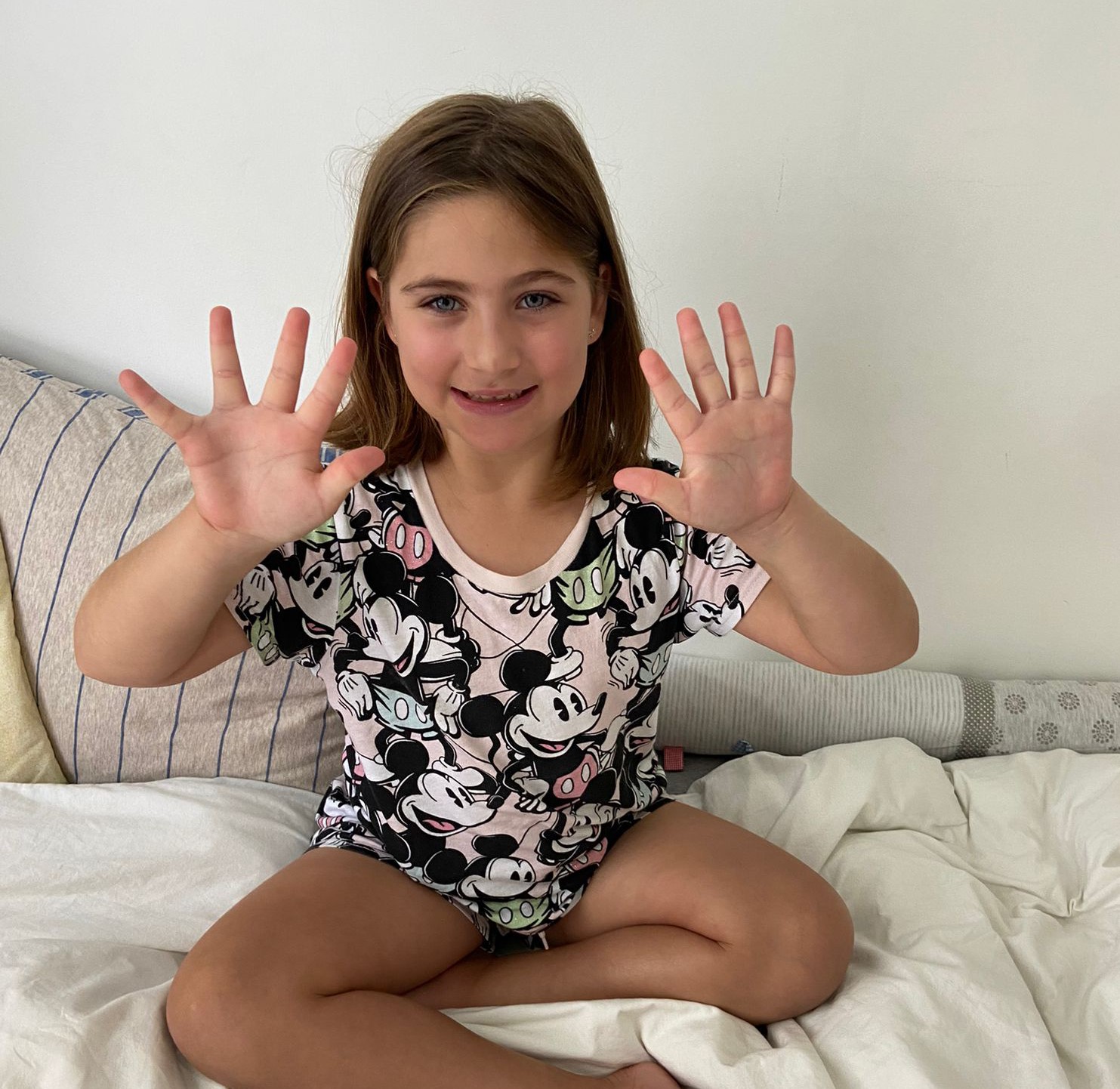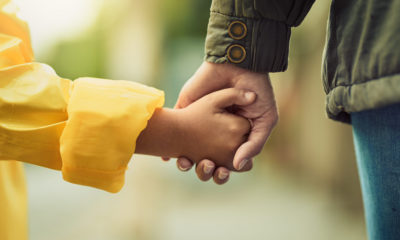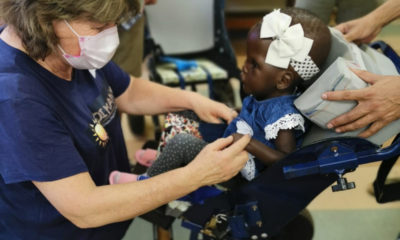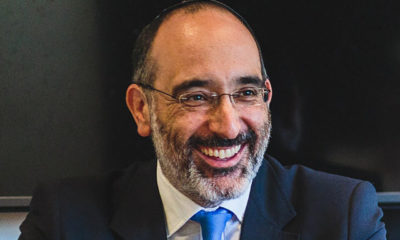
Banner

Counting blessings after child born with extra digits
Published
2 years agoon
When Lily Shifrin was laid on her mother’s chest after she was born in a Tel Aviv hospital, the doctor asked casually, “Did you see her six fingers?” Her mother, Bianca (nee Rubin), grew up in South Africa, and thought maybe he had confused his translation from Hebrew to English.
But she quickly realised what he was talking about when she looked at her daughter’s hands and feet. Lily was born with six fingers on each hand, and six toes on one foot. Shifrin and her husband, Darren, were shocked, as was the doctor, who thought this would have been picked up on scans during her pregnancy. But it wasn’t, even though the extra fingers and toes are clearly visible on her pregnancy imaging.
Lily is now a healthy seven-year-old growing up in Ra’anana, who loves to dance and draw. Today, one can hardly notice the scars from the amputations that she had when she was a year old, exactly six years ago.
The condition is called polydactyly. “Children born with polydactyly could have one or more extra digits on their hands and/or feet,” says Shifrin. It’s common – about one out of every 500 to 1 000 babies are born with it.
Shifrin grew up in Sea Point, went to Herzlia, and matriculated in 2002. “I have a degree in education and I taught at Herzlia,” she says. “In 2010, I went to Israel for what was meant to be six months. After about three months, I extended my trip. I was loving Israel and felt at home here. I met my husband six weeks before I was due to fly back to South Africa.
“As it turns out, he was also born in Cape Town, but his family made aliya when he was two and a half. I flew back to South Africa but quickly realised that Israel was where I wanted to be. Later that year, I made aliya. I’m a teacher and my husband works for the Israel Electrical Company. We live in Ra’anana and have a freedom here that’s hard to describe.”
From birth, Lily had to endure medical tests, most of which could have been performed on her mother if the condition had been picked up in pregnancy.
“Lilys’ first year was full of all the magical moments, but it was also very traumatic,” says Shifrin. “She had so many doctors’ appointments and check-ups. At six months, they put her under general aesthetic to do an MRI [magnetic resonance imaging]. By the time she had her amputation surgery at the age of one year and one month, she was terrified of doctors.”
One of the most traumatic aspects was that “a professor of genetics kept telling us that Lily must have some kind of syndrome over and above that which caused the extra digits even though her development was completely age-appropriate”, Shifrin says.
Shifrin’s maternal instinct told her that her daughter was healthy. “I wasn’t convinced and wanted another opinion. We found our way to one of the top geneticists in Israel, who once again checked her from head to toe and examined me and Darren. Eventually, we were told that while polydactyly is genetic, it seemed that in Lily’s case, it was a spontaneous mutation and she was perfectly normal – if there’s such a thing.”
They decided to amputate the extra digits as soon as Lily was old and strong enough to undergo the surgery. “We made the decision based on what we felt was best for Lily medically and emotionally, and to do it at a time that she would have no memory of the pain and recovery she went through,” says Shifrin.
Part of the reason for doing the surgery was that the extra toe made it difficult to find shoes that fit, and she was already walking before she turned one. The extra fingers, which were small “pinkie” fingers, would catch on clothes and also had an impact on her development – for example, making a fist.
Shifrin experienced a mix of emotions. On the one hand, she was traumatised, but on the other, she knew the condition was fixable. In doctors’ rooms, she would see children with complex challenges or incurable illnesses. So, it was difficult to accept that her pain was valid. At the same time, she was grateful for top medical treatment, that there was a solution, and that her daughter was healthy.
The road to surgery wasn’t easy as it required regular blood tests and x-rays. At first, surgeons said they wanted to do two operations, but the Shifrins implored them to make it one. And so, two orthopaedic specialists came together for a three-hour surgery. “The bones in her hand and foot were essentially double their size and split at the end. So it meant amputating as well as cutting that bone in half,” says Shifrin.
She remembers how on the day of the surgery, “Lily was very unsettled. She knew something was happening. Doctors usually give children a sedative before an operation, but it had the opposite effect on Lily, and she just screamed.”
The recovery also wasn’t easy. “She had already been walking and feeding herself. Now she couldn’t do anything. She was more frustrated than in pain. At one point, she bit the bandages. But we were lucky, at one point they discussed putting all three limbs in Plaster of Paris, which didn’t happen.”
Once the bandages came off, she went back to normal quickly and didn’t even need physio. However, Shifrin noticed that she used to rub the sides of her hands, and once said, “I feel something here.” She’s unsure if this could be the “phantom limb” that amputees experience. Physically, the amputation has had no impact on Lily’s development. Her parents have never hidden it from her, and she sees her extra digits as something special.
This wasn’t the end of tough experiences for Lily. When she was two, the family were at a Chanukah party when a dog bit her face, cutting her lip in half. “I heard a horrible growl and when I looked over, Lily’s face was in the dog’s mouth,” remembers Shifrin. Her daughter had to have 13 stitches.
“I wonder why she had to endure so much, but she’s incredibly strong,” says Shifrin. She’s a go-getter – much more Israeli than me or Darren!” The couple have since had two sons, Ben (5) and Dylan (1). Neither was born with polydactyly. “At every scan and at their births, all I kept asking was to count their fingers and toes!” she says. She urges others to make sure this is checked.
Shifrin says parents of children with challenges should never be ashamed and there’s always support if you look for it, especially in the age of social media. In turn, she would like to support the parents of children with polydactyly or other hardships. Looking back, she can’t believe the challenges they faced. “I’m just so grateful every day for my perfect and wonderful daughter,” she says.










